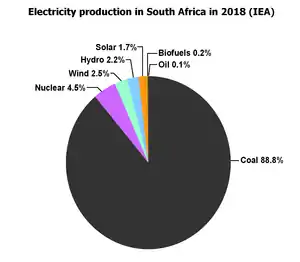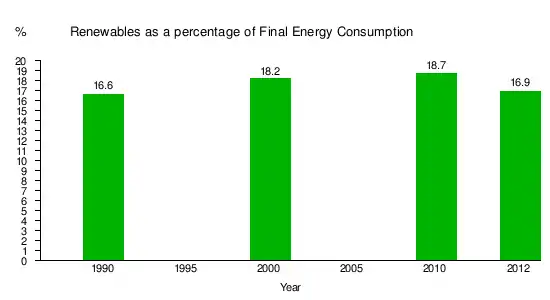Energy in South Africa
South Africa has a large energy sector, being the third-largest economy in Africa. The country consumed 227 TWh of electricity in 2018.[1] The vast majority of South Africa's electricity was produced from coal, with the fuel responsible for 88% of production in 2017.[2] South Africa is the 7th largest coal producer in the world.[2] As of July 2018, South Africa had a coal power generation capacity of 39 gigawatts (GW).[2] South Africa is the world's 14th largest emitter of greenhouse gases.[2] South Africa is planning to shift away from coal in the electricity sector. The country aims to decommission 34 GW of coal-fired power capacity by 2050.[2] It also aims to build at least 20 GW of renewable power generation capacity by 2030.[3]

South Africa aims to generate 77,834 megawatts (MW) of electricity by 2030, with new capacity coming significantly from renewable sources to meet emission reduction targets.[4]
Overview
| Population (million) |
Prim. energy (TWh) |
Production (TWh) |
Export (TWh) |
Electricity (TWh) |
CO2-emission (Mt) | |
|---|---|---|---|---|---|---|
| 2004 | 45.5 | 1,525 | 1,814 | 279 | 226 | 343 |
| 2007 | 47.6 | 1,562 | 1,856 | 254 | 239 | 346 |
| 2008 | 48.7 | 1,564 | 1,895 | 203 | 232 | 337 |
| 2009 | 49.3 | 1,675 | 1,868 | 158 | 224 | 369 |
| 2010 | 50.0 | 1,592 | 1,889 | 199 | 240 | 347 |
| 2012 | 50.6 | 237 | 368 | |||
| Change 2004-10 | 9.8% | 4.4% | 4.1% | -29% | 6.0% | 1.0% |
| Mtoe = 11.63 TWh, Prim. energy includes energy losses | ||||||
Electricity

The Electricity sector in South Africa is an important part of energy in South Africa.
Eskom is the state-owned electricity provider.[7] A 2016 study compared long term prices of different types of new powerplants.[8]Coal
Around 77% of South Africa's energy needs are directly derived from coal[9] and 92% of coal consumed on the African continent is mined in South Africa.[10] According to their official website, this is unlikely to change very much in the next few decades, as there is considered to be a "relative lack of suitable alternatives to coal as an energy source." The mining done natively in South Africa is split 51/49 between underground and open-cast mining. This mining is relatively concentrated; 11 mines account for 70 percent of the output.[11]
South Africa was the sixth top hard coal producer in 2009: 247 Mt hard coal, below Australia 335 Mt and Indonesia 263 Mt and above Russia 229 Mt. South Africa was the fifth top hard coal net exporter in 2009: 67 Mt hard coal of the world total hard coal export 836 Mt.[12]
In 2009 247 Mt hard coal production is 247 Mt*0.564 toe/Mt*11.630 TWh/toe = 1620 TWh and export 67 Mt*0.564 toe/Mt*11.630 TWh/toe = 439 TWh.
Coal and environment
Coal production and use creates in South Africa Coal combustion wastes (CCW), coal mine wastes (AMD) and toxic coal land fires. Coal combustion wastes (CCW), contain toxic substances like arsenic, cadmium, chromium and lead. Hundreds of South African old coal mines are filled with sulphate salts, heavy metals and carcinogenic substances like benzene and toluene. This AMD damages wildlife and spreads illness and disease. According to Greenpeace most shockingly is eMalahleni 'place of coal', Mpumalanga province, surrounded by 22 collieries and steel, vanadium and manganese plants. One of the biggest old mines is the Transvaal and Delagoa Bay (T&DB) mine, closed in 1953. 60 km downstream from Emalahleni AMD leaked into the water supply in 2006 and 2007 killing thousands of fish, crocodiles and freshwater turtles and poisoning the water used by communities. Coal fires continue in the disused mines.[13]
Coal business
Coal mine companies include Ingwe Collieries Limited, Anglo Coal (formerly Amcoal), Sasol, Eyesizwe, and Kumba Resources Limited, which together accounts for 85% of the saleable coal production.[11]
Renewable energy
The portion of renewable energy as a percentage of final energy consumption in 2012 was 16.9%. Most of that was from the burning of traditional biofuels for heating.
6.6% of electricity produced in South Africa in 2018 came from renewables (wind power, hydropower and solar power; biofuels did not contribute much to electricity production).[14]

|
In terms of share of GDP in 2012, South Africa was the fourth largest investor in renewable power in the world after Uruguay, Mauritius and Costa Rica. That rate of investment is expected to continue. Renewable energy will play a larger role in future.[16]
South Africa's per capita greenhouse gas emissions are the highest in Africa.[17]
South Africa's commitment to renewable energy lags behind that of China, India, Brazil, and Russia. South Africa receives more than twice as much sunshine than Germany, where over 15 percent of the national electricity supply comes from renewable sources.[18][19][20][21]
Government incentives
"South Africa's National Energy Regulator (NERSA) announced 31 March 2009 the introduction of a system of feed-in tariffs designed to produce 10 TWh of electricity per year by 2013. The feed-in tariffs announced were substantially higher than those in NERSA's original proposal. The tariffs, differentiated by technology, will be paid for a period of 20 years.
NERSA said in its release that the tariffs were based, as in most European countries, on the cost of generation plus a reasonable profit. The tariffs for wind energy and concentrating solar power are among the most attractive worldwide.
The tariff for wind energy, 1.25 ZAR/kWh (€0.104/kWh) is greater than that offered in Germany and more than that proposed in Ontario, Canada.
The tariff for concentrating solar, 2.10 ZAR/kWh, is less than that in Spain, but offers great promise in the bright sunlight of South Africa. NERSA's revised program followed extensive public consultation.
Stefan Gsänger, Secretary General of the World Wind Energy Association said in a release that "South Africa is the first African country to introduce a feed-in tariff for wind energy. Many small and big investors will now be able to contribute to the take-off of the wind industry in the country. Such decentralised investment will enable South Africa to overcome its current energy crisis. It will also help many South African communities to invest in wind farms and generate electricity, new jobs and new income. We are especially pleased as this decision comes shortly after the first North American feed-in law has been proposed by the Government of the Canadian Province of Ontario".[22]
However, the feed-in tariff was abandoned before being promulgated in favor of a competitive bidding process launched on 3 August 2011. Under this bidding process, the South African government plans to procure 3,750 MW of renewable energy: 1,850 MW of onshore wind, 1,450 MW of solar PV, 200 MW of CSP, 75 MW of small hydro, 25 MW of landfill gas, 12.5 MW of biogas, 12.5 MW of biomass, and 100 MW of small projects. The bidding process comprises two steps:
- Qualification phase. Projects are assessed based on structure of the project, legal, land acquisition and use, financial, environmental consent, technical, economic development and bid guarantee
- Evaluation phase. Compliant bids are then evaluated based on: (1) price relative to a ceiling provided in bid documentation, accounting for 70% of the decision, and (2) economic development, accounting for 30% of the decision.
The first round of bids was due on 4 November 2011. The SA government is expected to announce preferred bidders before COP17 in December. PPA's are expected to be in place by June 2012. Projects should be commissioned by June 2014, except CSP projects which are expected by June 2015.
The average indexed bid prices (2012) for the supply of energy in the first bid window for the various renewable energy technologies were:
- Concentrating solar power (CSP): R2,69 per kWh
- Solar photo-voltaic (PV): R2,76 per kWh
- Wind: R1,14 per kWh
The average indexed bid prices (2012) for the supply of energy in the second bid window
- Concentrating solar power (CSP): R2,51 per kWh
- Solar photo-voltaic (PV): R1,65 per kWh
- Wind: R0,90 per kWh
- Small hydro: R1,03 per kWh
The average indexed bid prices (2013) for the supply of energy in the third bid window
- Concentrating solar power (CSP): R1,64 per kWh
- Solar photo-voltaic (PV): R0,99 per kWh
- Wind: R0,74 per kWh
- Landfill gas: R0,94 per kWh
- Biomass: R1,39 per kWh
Eskom claims a standard electricity production price (2012)of R0.31 per kWh (Eskom-predominately Coal and Nuclear),[23] however energy generated from Eskom's new coal power plants have been estimated to be R0.97 per kWh.
Nuclear power
Koeberg nuclear power station accounted for 4.5% of the country's electricity production in 2018.[14] It has two pressurized water reactors based on a French design and rated at 0.93 GW net power each (1.86 GW in total). It is the only commercial nuclear powerplant in the African continent.
Controversies
Secret price contracts between Eskom and the Australian mining company BHP Billiton less than half Eskom's reported production price in the period.[24]
Many abandoned mines have been burning since the 1940s. Persistent and toxic mine chemical leakages pollute waterways and kill animals. In 2006, about 80% of South Africa's coal exports was in Europe.[13]
References
- "South Africa - Countries & Regions". IEA. Retrieved 3 August 2020.
- "The Carbon Brief Profile: South Africa". Carbon Brief. 15 October 2018. Retrieved 3 August 2020.
- "South Africa Energy Outlook – Analysis". IEA. Retrieved 16 June 2020.
- "Renewables in, coal out: South Africa's energy forecast". Renewable Energy World. 18 October 2019. Retrieved 16 June 2020.
- IEA Key World Energy Statistics Statistics 2013, 2012 Archived 9 March 2013 at the Wayback Machine, 2011 Archived 27 October 2011 at the Wayback Machine, 2010 Archived 11 October 2010 at the Wayback Machine, 2009 Archived 7 October 2013 at the Wayback Machine, 2006 Archived 12 October 2009 at the Wayback Machine IEA October, crude oil p.11, coal p. 13 gas p. 15
- "Data tables – Data & Statistics".
- OECD, African Development Bank, United Nations Economic Commission for Africa (4 December 2009). African Economic Outlook 2009 : Country Notes: Volumes 1 and 2. OECD Publishing. p. 583. ISBN 9789264076181. Retrieved 20 September 2013.
{{cite book}}: CS1 maint: multiple names: authors list (link) - http://www.ee.co.za/wp-content/uploads/2016/10/New_Power_Generators_RSA-CSIR-14Oct2016.pdf
- "Coal". Department of Energy (South Africa). Retrieved 8 January 2010.
- "International Energy Outlook 2009, Chapter 4 – Coal". Energy Information Administration. 27 May 2009. Retrieved 14 January 2010.
- "Energy Sources: Coal | Department: Energy | REPUBLIC OF SOUTH AFRICA". www.energy.gov.za. Retrieved 23 January 2020.
- IEA Key energy statistics 2010 Archived 11 October 2010 at the Wayback Machine Page 15
- The True Cost of Coal Greenpeace 27 November 2008 pages 48–53
- "Data tables – Data & Statistics". IEA. Retrieved 11 March 2022.
- "Global Tracking Framework 2015". The World Bank. Archived from the original on 5 September 2015. Retrieved 14 October 2015.
- "RENEWABLES 2014 GLOBAL STATUS REPORT". REN21. Retrieved 30 March 2015.
- Laboratory, Oak Ridge National. "Carbon Dioxide Information Analysis Center (CDIAC)". cdiac.ess-dive.lbl.gov. Retrieved 26 November 2017.
- http://www.tips.org.za/files/184.pdf
- "Statistics South Africa Category Archives: Energy". 27 July 2017. Retrieved 25 November 2017.
- "CO2 Emissions from Fuel Combustion: 2011Highlights". IEA. Archived from the original on 17 April 2010. Retrieved 17 October 2011.
- "World's Largest Solar Park to be in South Africa?". CleanTechnica. 26 October 2010. Retrieved 17 October 2011.
- http://www.renewableenergyworld.com/rea/news/article/2009/04/south-africa-introduces-aggressive-feed-in-tariffs "South Africa Introduces Aggressive Feed-in Tariffs" , Paul Gipe, Contributing Writer, 10 April 2009
- "Renewable Energy IPP Procurement Programme: Window two Preferred Bidders' announcement". Department of Minerals and Energy. Retrieved 13 July 2013.
- Who's holding us back? Full report. Greenpeace, 23 November 2011
External links
| Wikimedia Commons has media related to Energy in South Africa. |